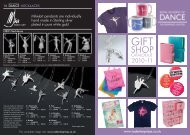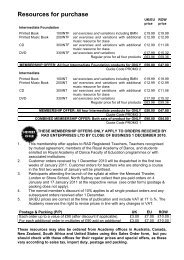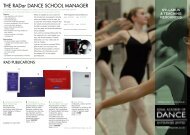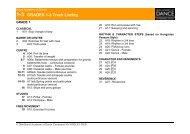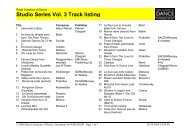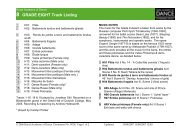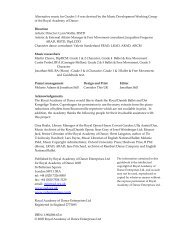to download the guide book in - Royal Academy of Dance Enterprises
to download the guide book in - Royal Academy of Dance Enterprises
to download the guide book in - Royal Academy of Dance Enterprises
Create successful ePaper yourself
Turn your PDF publications into a flip-book with our unique Google optimized e-Paper software.
Rhythm types <strong>in</strong> triple metre<br />
Waltz types<br />
As a dance which has enjoyed two centuries <strong>of</strong> popularity, it is hardly surpris<strong>in</strong>g that<br />
<strong>the</strong>re should be so many variants. The English or Bos<strong>to</strong>n waltz is generally slow, with a<br />
def<strong>in</strong>ite weight <strong>to</strong> <strong>the</strong> beg<strong>in</strong>n<strong>in</strong>g <strong>of</strong> <strong>the</strong> bar, and this makes it suitable for exercises such as<br />
ronds de jambe á terre or balancés. The early German waltz, that is found <strong>in</strong> <strong>the</strong> pas de trois<br />
from Les Pat<strong>in</strong>eurs, <strong>the</strong> waltz and f<strong>in</strong>ale <strong>of</strong> Peasant Pas de Deux from Giselle is marked by a<br />
three‐<strong>in</strong>‐a‐bar feel, ra<strong>the</strong>r like <strong>the</strong> mazurka, and <strong>of</strong>ten has a cont<strong>in</strong>uous runn<strong>in</strong>g eighth‐<br />
note movement <strong>in</strong> <strong>the</strong> melody. The common <strong>in</strong>terpretation <strong>of</strong> <strong>the</strong> term Viennese waltz is<br />
a waltz with a one‐<strong>in</strong>‐a‐bar feel, where <strong>the</strong> first beat has a k<strong>in</strong>d <strong>of</strong> hiccup which gives <strong>the</strong><br />
dance a sw<strong>in</strong>g.<br />
The waltz song has a tendency <strong>to</strong> be less rhythmic than waltzes written for danc<strong>in</strong>g, and<br />
is <strong>of</strong>ten <strong>in</strong> four‐bar phrases, ra<strong>the</strong>r than <strong>the</strong> more usual two. We have termed ʹwaltz<br />
variationsʹ those compositions which accompany solos, particularly <strong>in</strong> <strong>the</strong> Imperial<br />
Russian reper<strong>to</strong>ire. Although <strong>the</strong>y are <strong>in</strong> triple metre, and much like waltzes, <strong>the</strong>y have a<br />
much heavier and more bombastic rhythm than <strong>the</strong> waltz as a social dance and are<br />
peculiar <strong>to</strong> <strong>the</strong> ballet reper<strong>to</strong>ire. The Grande valse is not a dance term, but a musical one –<br />
it refers more <strong>to</strong> <strong>the</strong> length <strong>of</strong> <strong>the</strong> waltz, ra<strong>the</strong>r than its dynamics, and is used by<br />
composers who wrote extended (sometimes symphonically constructed) waltzes for <strong>the</strong><br />
concert hall.<br />
The waltz from The Two Pigeons used for D19: Balancés en avant and en arrière is a type<br />
sometimes known as a ‘m<strong>in</strong>im waltz’, <strong>in</strong> which <strong>the</strong> melody moves <strong>in</strong> m<strong>in</strong>ims (half‐notes)<br />
aga<strong>in</strong>st <strong>the</strong> crotchet (quarter‐note) movement <strong>of</strong> <strong>the</strong> accompaniment. This creates a<br />
hemiola effect, where <strong>the</strong> melody is effectively <strong>in</strong> waltz‐time at half <strong>the</strong> speed <strong>of</strong> <strong>the</strong> waltz<br />
accompaniment, creat<strong>in</strong>g <strong>in</strong>terest<strong>in</strong>g cross‐rhythms. This device is favoured by<br />
Tchaikovsky, and appears <strong>in</strong> nearly every waltz he wrote, notably <strong>in</strong> <strong>the</strong> waltz from<br />
Sleep<strong>in</strong>g Beauty, Act I <strong>in</strong> <strong>the</strong> fourth phrase, and <strong>to</strong> an extreme extent <strong>in</strong> ‘Snowflakes’ from<br />
The Nutcracker.<br />
Mazurka types<br />
The ma<strong>in</strong> difference between mazurkas and waltzes is that <strong>the</strong>y tend <strong>to</strong> have three<br />
def<strong>in</strong>ite accents <strong>in</strong> each bar, whereas waltzes have a pronounced accent only on <strong>the</strong> first<br />
beat (except <strong>the</strong> early German waltz, q.v.). Chop<strong>in</strong>ʹs mazurkas are <strong>in</strong> fact examples <strong>of</strong><br />
three different types <strong>of</strong> Polish dance, <strong>the</strong> mazur, <strong>the</strong> oberek (or obertás) and Kujawiak.<br />
Broadly speak<strong>in</strong>g, <strong>the</strong> Kujawiak is <strong>the</strong> slowest and most lyrical <strong>of</strong> <strong>the</strong> three, <strong>the</strong> mazur (or<br />
mazurka) <strong>of</strong> medium tempo, and <strong>the</strong> oberek <strong>the</strong> fastest. See DZIEWANOWSKA (1997),<br />
MCKEE (2004) and TROCHIMCZYK, M. (2000) for detailed explanations. The mazurka was<br />
not just a Polish national dance, but also a very popular social dance <strong>in</strong> European<br />
ballrooms.<br />
24



